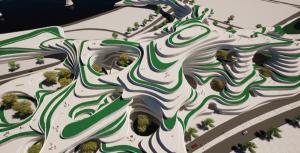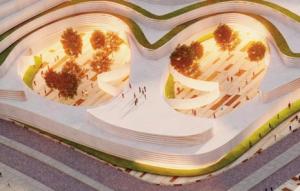
Scientists designing self-learning buildings to alleviate impact of scorching heat in oil-rich Gulf states
SHARJAH, EMIRATE OF SHARJAH, UNITED ARAB EMIRATES, July 23, 2024 /EINPresswire.com/ -- Scientists from the University of Sharjah in the United Arab Emirates (UAE) are racing against time to come up with new building designs that will alleviate the impact of blazing heat gripping the oil-rich Gulf states particularly during the long sweltering summer (May to September).
They say the designs they are working on will be constructed with intelligent materials and air conditioning with low thermal conductivity to replace current vampire air conditioning appliances that are kept on 24 hours per day. The Gulf region is reputed for its scorching heat in the summer months which may occasionally break the benchmark of 50 degrees Celsius.
They are researching the use of algorithms and parameters to solve current design problems and produce buildings that can adapt and learn from the environment. (See sample of research published in IOP Conference Series: Earth and Environmental Science (https://iopscience.iop.org/article/10.1088/1755-1315/1019/1/012047/meta)
“I want to come up with designs of a self-learning building that is capable of adapting and learning from the environment,” says Dr. Aref Maksoud, the study’s main author and an Assistant Professor at Sharjah University’s College of Engineering.
Co-author Hayder Al-Beer, an engineer, adds: “Self-learning buildings’ significance is in its potential to revolutionize the way we design, build, and operate buildings, making them more energy-efficient, comfortable, safe, and durable.”
Almost all sorts of buildings in the Gulf, among them some of the world’s most known high rises, are mostly made of reinforced concrete and steel, with large panes of glass, which are no proof to the sweltering heat outside.
Studies on designing smart buildings like the ones by Dr. Maksoud and colleagues have been underway in different parts of the world as scientists expect some worst-case scenarios amid unpredictable weather conditions.
However, the designs by Dr. Maksoud and his co-authors stand out in their reliance on computational methods and green and recycled materials to create futuristic and environment-adaptive buildings.
“Our work fills a gap in the field of architecture by exploring the potential of computational design (CD) to create buildings that are more environmentally responsible and adaptable,” says Dr. Maksoud.
Dr. Maksoud says their designs are “distinguished from current prevalent designs through the integration of advanced technology, energy efficiency, environmental sustainability, adaptive capabilities, occupant comfort, and long-term cost savings.”
Computational design is a novel method that draws on algorithms and parameters to solve design problems. “If this project is done in a particular place, the intelligent building system would be able to study and collect information internally about the culture of that place and adapt itself to that culture.
“It would use sensors to know the number of people in the building, the period of time that they spend together, the clothes they are wearing, and the actions they are taking,” notes Dr. Maksoud.
The scientists’ designs have already attracted exhibitors attending Dubai Design Week. The UAE, grabbling with intense summer heat every year, “has shown keen interest in adopting innovative and eco-friendly building practices to create more sustainable and futuristic cities,” notes Dr. Maksoud.
The designs bring about a shift in construction. Reinforced concrete and steel will still be used to provide the building’s mainstay. Otherwise, “green and recycled materials, high-performance insulation, smart glass, green roofs, energy-efficient systems, solar panels, water-efficient fixtures, prefabricated construction, and biodegradable finishes” will make up the largest portion of materials, according to Dr. Maksoud.
Once implemented, the buildings will have improved temperature regulation, occupant comfort by automated sensor-based systems, integration between sustainable air-conditioning and renewable energy systems, and reduced energy consumption with AI monitoring greenhouse emissions.
In one of their designs, for instance, the scientists visualize a building to guard against the COVID-19 pandemic and how it could safeguard its inhabitants against the potential challenges posed by the pandemic.
“In this case, the building would adapt by activating social distancing from within the building, which could be done through the communication between the CD cloud system of the building and the robots which are inside the building.
“Another way to deal with COVID-19 challenges could be by placing innovative skin on the buildings' interior walls, which do not pick up germs. This can ensure that the spaces are sanitized at all times,” the scientists write in one of their studies.
“When it comes to the performance of buildings, new automation systems can be used to control security, comfort, and energy efficiency. AI enables buildings to become places driven by real-time data and feedback, communicating with itself like a living organism. AI-based energy management platforms can track usage patterns to create tenants' proper conditions, conserving energy and money,” the authors point out.
Al-Beer notes how smart buildings are slowly but steadily “becoming more sophisticated, affordable, and widely adopted. As smart building technology continues to evolve, we can expect to see smart buildings playing an increasingly important role in our lives. By reducing energy consumption and increasing the durability of buildings, smart buildings can help us to create a more sustainable future.”
Employing striking technical breakthroughs to produce environment-friendly computation designs, the researchers are moving closer to turning their dream into reality.
Instead of almost solely relying on reinforced concrete – as is the case in most building structures in the Gulf – future buildings could be computationally designed, using construction materials that alleviate impact of stifling heat outside.
In his current job as an architect, Al-Beer has already executed these smart strategies. “Actually, I'm already implementing these strategies in my architecture practice to create top notch innovative solutions to real life problems in the AEC (Architecture, Engineering, and Construction) industry.”
LEON BARKHO
University Of Sharjah
971501654376
email us here
EIN Presswire does not exercise editorial control over third-party content provided, uploaded, published, or distributed by users of EIN Presswire. We are a distributor, not a publisher, of 3rd party content. Such content may contain the views, opinions, statements, offers, and other material of the respective users, suppliers, participants, or authors.



